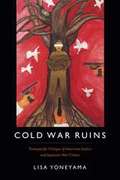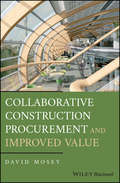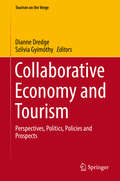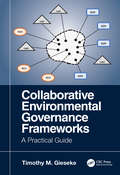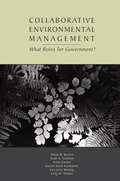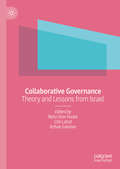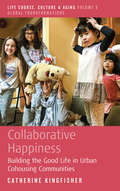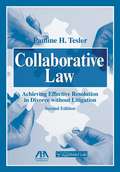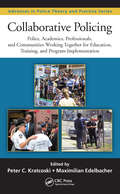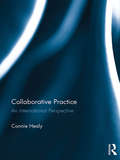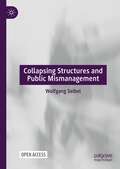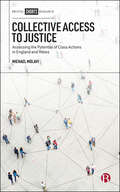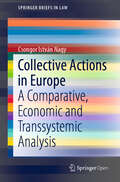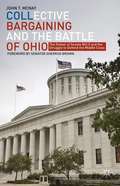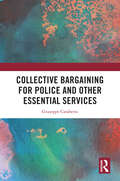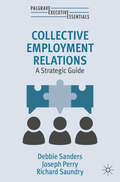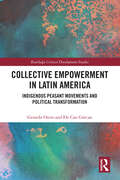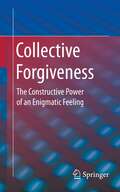- Table View
- List View
Cold Steel: Lakshmi Mittal and the Multi-Billion-Dollar Battle for a Global Empire
by Tim Bouquet Byron OuseyWhen the world's two largest steel producers went head to head in a bitter struggle for market domination, an epic corporate battle ensued that sent shockwaves through the political corridors of Europe, overheated the world's financial markets and transformed the steel industry. Billions of dollars were at stake.At the heart of the battle were two men: Guy Dollé, Chairman and CEO of Luxembourg-based Arcelor, the world's largest steel producer by turnover and Lakshmi Mittal, a self-made Indian industrialist and the richest man in Great Britain. Only one could prevail . . .
Cold War Ruins: Transpacific Critique of American Justice and Japanese War Crimes
by Lisa YoneyamaIn Cold War Ruins Lisa Yoneyama argues that the efforts intensifying since the 1990s to bring justice to the victims of Japanese military and colonial violence have generated what she calls a "transborder redress culture." A product of failed post-World War II transitional justice that left many colonial legacies intact, this culture both contests and reiterates the complex transwar and transpacific entanglements that have sustained the Cold War unredressability and illegibility of certain violences. By linking justice to the effects of American geopolitical hegemony, and by deploying a conjunctive cultural critique--of "comfort women" redress efforts, state-sponsored apologies and amnesties, Asian American involvement in redress cases, the ongoing effects of the U.S. occupation of Japan and Okinawa, Japanese atrocities in China, and battles over WWII memories--Yoneyama helps illuminate how redress culture across Asia and the Pacific has the potential to bring powerful new and challenging perspectives on American exceptionalism, militarized security, justice, sovereignty, forgiveness, and decolonization.
Cold Waters: Tangible and Symbolic Seascapes of the North (Springer Polar Sciences)
by Arja Rosenholm Elena Trubina Markku Lehtimäki Nina TynkkynenThis book addresses the Arctic and the northern regions by exploring cold waters and northern seascapes. It focuses on cultural discourses and artistic representations concerning the human experience and imagination of how the Arctic Ocean has been explored and used. It aims to assess what is specific to the northern waters vis-à-vis other sea and water areas in the world. The contextual background is provided by the fundamental shift from terra-based thinking towards aqua-based thinking, including the histories of the northern waters and the innovative ocean studies of the last decades. This book will be of interest to readers in Arctic studies and Sea and Ocean studies (including those with interests in literature, history, cultural and film studies, anthropology and politics), Environmental History and Cultural studies as well as in Russian studies. The book has been assembled with a view towards upper-level undergraduate and post-graduate students and scholars and will also be appropriate for courses in the fields mentioned above. The book will be of interest to specialists working in and with Arctic environmental issues. There is a broad array of international academic networks, environmental, governance and cultural associations outside academia whose members may also find the book of interest.
Collaborating for Climate Resilience (Giving Voice to Values)
by Ann Goodman Nilda MesaSupporters of environmental well-being and climate resilience are awakening and mobilizing – cities, states, business, academia, community-based organizations, and the military. They understand the imminent and long-term risks of climate deterioration and they are creating new structures beyond the top-down government policy efforts of the past. This highly practical book provides a clear insight into these collaborative solutions by real organizations in real time. It demonstrates how people from disparate fields and stakeholders cooperate to address climate issues at ground level and reveals how this can be undertaken effectively. Through case studies of key organizations such as the NYC Sustainability Office, Detroiters Working for Environmental Justice, IBM, and West Point Military Academy, readers will understand each party’s role in a cooperative enterprise and the means by which they support climate resiliency, their institutional goals, and their communities. Of particular value, the book illustrates the co-benefits of multi-party resilience planning: faster approval times; reduced litigation; ability to monetize benefits such as positive health outcomes; the economic benefits of cooperation (for example, capacity building through financing climate planning and resilience across public, private, and other sources of funding); and developing a shared perspective. The book will be of great interest to business managers, policymakers, and community leaders involved in combating climate change, and researchers and students of business, public affairs, policy, environment, climate, and urban studies.
Collaborative Construction Procurement and Improved Value
by David MoseyThe guide that explores how procurement and contracts can create an integrated team while improving value, economy, quality and client satisfaction Collaborative Construction Procurement and Improved Value provides an important guide for project managers, lawyers, designers, constructors and operators, showing step by step how proven collaborative models and processes can move from the margins to the mainstream. It covers all stages of the project lifecycle and offers new ways to embed learning from one project to the next. Collaborative Construction Procurement and Improved Value explores how strategic thinking, intelligent team selection, contract integration and the use of digital technology can enhance the value of construction projects and programmes of work. With 50 UK case studies, plus chapters from specialists in 6 other jurisdictions, it describes in detail the legal and procedural route maps for successful collaborative teams. Collaborative Construction Procurement and Improved Value: Examines the ways to create an effective contract that will spell success throughout the procurement process Contains helpful case studies from real-world projects and programmes Explores the benefits of the collaborative construction process and how to overcome common obstacles Bridges the gaps between contract law, collaborative working and project management Includes the first analysis of the NEC4 Alliance Contract, the FAC-1 Framework Alliance Contract and the TAC-1 Term Alliance Contract
Collaborative Economy and Tourism
by Dianne Dredge Szilvia GyimóthyThis book employs an interdisciplinary, cross-sectoral lens to explore the collaborative dynamics that are currently disrupting, re-creating and transforming the production and consumption of tourism. House swapping, ridesharing, voluntourism, couchsurfing, dinner hosting, social enterprise and similar phenomena are among these collective innovations in tourism that are shaking the very bedrock of an industrial system that has been traditionally sustained along commercial value chains. To date there has been very little investigation of these trends, which have been inspired by, amongst other things, de-industrialization processes and post-capitalist forms of production and consumption, postmaterialism, the rise of the third sector and collaborative governance. Addressing that gap, this book explores the character, depth and breadth of these disruptions, the creative opportunities for tourism that are emerging from them, and how governments are responding to these new challenges. In doing so, the book provides both theoretical and practical insights into the future of tourism in a world that is, paradoxically, becoming both increasingly collaborative and individualized.
Collaborative Environmental Governance Frameworks: A Practical Guide
by Timothy GiesekeThis book takes a practical approach to understanding and describing collaborative governance for resolving environmental problems. It introduces a new collaborative governance assessment model and recognizes that collaborations are a natural result of organizations converging around complex issues. Rather than identifying actors by their type of organization, the actors are identified by the type of role they play. This approach is aligned with how individuals and organizations interact in practice, and their dependance on collaborations to solve emerging environmental problems. The book discusses real cases with governance issues and creates new frameworks for collaborations. Features: Addresses communities at all levels and scales that are gravitating toward collaborations to solve their environmental issues. Prepares and enables individuals to participate in collaborative governance and design collaborative governance frameworks. Introduces the first simplified and standardized model to assess governance using governance actors and styles. Explains governance in simple terms and builds governance frameworks from the individual’s perspective; the smallest, viable unit of governance in a collaboration. Describes "tools of convergence" for collaborative leaders to organize and align activities to create shared-governance outcomes and outputs.
Collaborative Environmental Management: What Roles for Government-1
by Tomas M. Koontz Toddi A. Steelman JoAnn Carmin Katrina Smith Korfmacher Cassandra Moseley Craig W. ThomasCollaboration has become a popular approach to environmental policy, planning, and management. At the urging of citizens, nongovernmental organizations, and industry, government officials at all levels have experimented with collaboration. Yet questions remain about the roles that governments play in collaboration--whether they are constructive and support collaboration, or introduce barriers. This thoughtful book analyzes a series of cases to understand how collaborative processes work and whether government can be an equal partner even as government agencies often formally control decision making and are held accountable for the outcomes. Looking at examples where government has led, encouraged, or followed in collaboration, the authors assess how governmental actors and institutions affected the way issues were defined, the resources available for collaboration, and the organizational processes and structures that were established. Cases include collaborative efforts to manage watersheds, rivers, estuaries, farmland, endangered species habitats, and forests. The authors develop a new theoretical framework and demonstrate that government left a heavy imprint in each of the efforts. The work concludes by discussing the choices and challenges faced by governmental institutions and actors as they try to realize the potential of collaborative environmental management.
Collaborative Governance: Theory and Lessons from Israel
by Itzhak Galnoor Neta Sher-Hadar Lihi LahatThis book is the first to explore collaborative governance arrangements in Israel. It offers a new, modular definition of collaborative governance, focusing on its contributions toward public values and democracy. The book discusses different kinds of collaborations, their scope, implications and impact on governability in Israel, a country which provides an interesting setting for learning about collaborative governance, given its heterogenous population and the nature of the relationship between the state’s civil service, the business sector and the civil society. The book presents examples derived from local, and central government levels, and from policy areas such as education, regulation and local government.
Collaborative Happiness: Building the Good Life in Urban Cohousing Communities (Life Course, Culture and Aging: Global Transformations #8)
by Catherine KingfisherUnderstudied relative to other forms of intentional community, and under-recognized in policy-making circles, urban cohousing communities situate wellbeing as simultaneously social and subjective, while catering for groups of people so diverse in age. Collaborative Happiness looks at two such urban cohousing communities: Kankanmori, in Tokyo; and Quayside Village, in Vancouver. In expanding beyond mainstream approaches to happiness focused exclusively on the individual, Quayside Village and Kankanmori provide an alternative model for how to understand and practice the good life in an increasingly urbanized world marked by crisis of both social and environmental sustainability.
Collaborative Happiness: Building the Good Life in Urban Cohousing Communities (Life Course, Culture and Aging: Global Transformations #8)
by Catherine KingfisherUnderstudied relative to other forms of intentional community, and under-recognized in policy-making circles, urban cohousing communities situate wellbeing as simultaneously social and subjective, while catering for groups of people so diverse in age. Collaborative Happiness looks at two such urban cohousing communities: Kankanmori, in Tokyo; and Quayside Village, in Vancouver. In expanding beyond mainstream approaches to happiness focused exclusively on the individual, Quayside Village and Kankanmori provide an alternative model for how to understand and practice the good life in an increasingly urbanized world marked by crisis of both social and environmental sustainability.
Collaborative Law: Achieving Effective Resolution in Divorce Without Litigation
by Pauline H. TeslerCollaborative law is a powerful dispute resolution model that is continuing to grow in popularity. Spouses are represented by counsel that assists in bringing them through divorce with integrity and satisfaction. A binding stipulation disqualifies both counsels if either party threatens or elects to go to court. This book explains the goals, concepts and techniques of collaborative law in a clear, insightful manner. Includes forms and Client Handbook on CD-ROM.
Collaborative Policing: Police, Academics, Professionals, and Communities Working Together for Education, Training, and Program Implementation (Advances in Police Theory and Practice)
by Peter C. Kratcoski Maximilian Edelbacher"The chapters in this book reveal that police education, training, and practices are now closely tied to collaboration between police, academics, professional practitioners, and community agencies, and such collaboration is described and evaluated." Dilip K. Das, PhD, Founding President, International Police Executive Symposium (IPES) and founding
Collaborative Practice: An International Perspective
by Connie HealyCollaborative practice is a new method of dispute resolution, used mainly in family law matters. By taking a non-adversarial approach, it challenges the strictly positivist view of the lawyer as ‘zealous advocate’ for the client. As such, it has received much criticism from the established Bar and legal profession. This book provides a doctrinal and empirical analysis of collaborative practice with a view to assessing its place within the dispute resolution continuum and addressing whether this criticism has been justified. It begins by establishing the theoretical underpinnings of conflict and differing approaches to conflict resolution, the impact of the comprehensive law movement and therapeutic jurisprudence. The origins and development of the collaborative process and the framework it provides for a multidisciplinary approach to conflict resolution is outlined. The book addresses the examination of the process undertaken in the lead up to the enactment of the Uniform Collaborative Law Act in 2010; now regarded as a model of best practice. Finally, through an examination of empirical research undertaken in the US, Canada and in England and Wales, and in presenting the results of the first known empirical research into the process in an Irish family law context, the book concludes with an evidenced based analysis of the process from the perspective of couples who chose to use the collaborative model to resolve the issues surrounding their relationship breakdown, collaborative lawyers and lawyers who do not advocate a non-adversarial approach. As such this book provides a valuable insight into the process which will be of interest to: academics; practising lawyers; members of the judiciary; researchers in the fields of conflict resolution and family law and for students studying alternative dispute resolution (ADR).
Collapsing Structures and Public Mismanagement
by Wolfgang SeibelThis open access book is about mismanagement of public agencies as a threat to life and limb. Collapsing bridges and buildings kill people and often leave many more injured. Such disasters do not happen out of the blue nor are they purely technical in nature since construction and maintenance are subject to safety regulation and enforcement by governmental agencies. This book analyses four relevant cases from Australia, New Zealand, the USA and Germany. Arguing that, while preventing disaster through public oversight is essentially easy, the difficult part for public officials and private contractors and consultants alike is to resist incentives that threaten professional skills and standards. Rather than stressing well-known pathologies of bureaucracy as a potential source of disaster, this book argues, learning for the sake of prevention should aim at neutralizing threats to integrity and strengthening a sense of responsibility among public officials.
Collective Access to Justice: Assessing the Potential of Class Actions in England and Wales
by Michael MolaviAt a time when the collective redress landscape is undergoing a period of transformative change, this important and timely research focuses on class actions in England and Wales. The author provides an objective analysis of the costs and benefits of these proceedings from an access to justice perspective. Aiming to promote accessibility, this pioneering work separates fact from fiction in an easily digestible way, offering progressive solutions for reform.
Collective Actions
by Stefan Wrbka Steven Van Uytsel Mathias SiemsThis volume of essays draws together research on different types of collective actions: group actions, representative actions, test case procedures, derivative actions and class actions. The main focus is on how these actions can enhance access to justice and on how to balance the interests of private actors in protecting their rights with the interests of society as a whole. Rather than focusing on collective actions only as a procedural device per se, the contributors to this book also examine how these mechanisms relate to their broader social context. Bringing together a broad range of scholarship from the areas of competition, consumer, environmental, company and securities law, the book includes contributions from Asian, European and North American scholars and therefore expands the scope of the traditional European and/or American debate.
Collective Actions in Europe: A Comparative, Economic and Transsystemic Analysis (SpringerBriefs in Law)
by Csongor István NagyThis open access book offers an analytical presentation of how Europe has created its own version of collective actions. In the last three decades, Europe has seen a remarkable proliferation of collective action legislation, making class actions the most successful export product of the American legal scholarship. While its spread has been surrounded by distrust and suspiciousness, today more than half of the EU Member States have introduced collective actions for damages and from those who did, more than half chose, to some extent, the opt-out system. This book demonstrates why collective actions have been felt needed from the perspective of access to justice and effectiveness of law, the European debate and the deep layers of the European reaction and resistance, revealing how the Copernican turn of class actions questions the fundamentals of the European thinking about market and public interest. Using a transsystemic presentation of the European national models, it analyzes the way collective actions were accommodated with the European regulatory environment, the novel and peculiar regulatory questions they had to address and how and why they work differently on this side of the Atlantic.
Collective Bargaining and the Battle of Ohio
by John T. McnayThe story of how the Ohio conference of the American Association of University Professors mobilized its resources and fought alongside Teamsters, firefighters, janitors, and police to defeat Ohio Senate Bill 5 by referendum, restoring collective bargain rights across the state.
Collective Bargaining for Police and Other Essential Services
by Giuseppe CarabettaThis book examines how collective bargaining disputes are resolved among police and essential service employees.In Australia, as in other common law countries, police and other highly essential employees such as fire-fighters and ambulance officers have long had access to a form of binding arbitration to settle collective bargaining disputes. The traditional arbitration-based system in Australia has, however, been replaced in recent decades with a marked-based collective bargaining system. The current (Fair Work) system restricts access to arbitration, favouring collective bargaining based on the parties’ prerogative to make their own agreements, and supported by a limited right to industrial action — including strikes — during bargaining. Yet, police officers, particularly, are subject to considerable restraints on any entitlement to participate in industrial action. The problem is that with limited access to arbitration, and an especially limited right to industrial action, intractable disputes may continue indefinitely, without any impasse-breaking process to prevent the flow-on harms of long-running police disputes. This raises the essential question underpinning this study: what form of dispute resolution system is appropriate to protect both the legitimate industrial interests of police officers, and the community’s interest in the uninterrupted provision of essential policing services?The author in his extensive field-work research and his study of international case studies has developed a useful model for mandatory interest arbitration among police and other essential services personnel. The lessons and recommendations in the book offer insights for essential services labour law in Australia and overseas.
Collective Bargaining in Labour Law Regimes: A Global Perspective (Ius Comparatum - Global Studies in Comparative Law #32)
by Ulla LiukkunenThis book addresses the theme of collective bargaining in different legal systems and explores legal framework of collective bargaining as well as the role of different bargaining models in domestic labour law systems in altogether twenty-one jurisdictions throughout the world. Recent development of collective bargaining regimes can be viewed as part of a larger development of labour law models that face increasing challenges caused by globalization and transition of work and workplaces. The book places particular emphasis on identifying and examining most important development trends affecting domestic labour law regimes and collective bargaining and regulatory responses thereto. The analysis offered extents to transnational dimension of collective bargaining. As the chapters analyse the influence of the legal frameworks of collective bargaining in different countries they provide unique comparative insight into the topic which is central to understanding the function of labour law.
Collective Employment Relations: A Strategic Guide (Palgrave Executive Essentials)
by Richard Saundry Joseph Perry Debbie SandersIn an era of rapid technological, economic and political change, there is a growing awareness of the challenges of income inequality, employment insecurity and workplace conflict. In this context, positive relationships between management and trade unions offer an opportunity to negotiate change and create fairer and more productive workplaces. Part of the Palgrave Executive Essentials series, this engaging text is the only dedicated resource for executive learners, professionals and students of human resources and labour relations, providing a strategic management guide to employee relations in the unionised workplace. Combining theory with practical examples and tools relating to negotiations with unions and management of a unionised workforce, this book is a one-stop-shop for students, instructors and practitioners looking to supplement their understanding of employment relations with hands-on knowledge of this vitally important context. It includes case studies, reflective questions, suggested resources and further reading for additional learning. It will be a vital resource for executive education courses on employment relations and managing a unionised workforce, as well as MBA students and exec-MA students, as well as the wider practitioner community.
Collective Empowerment in Latin America: Indigenous Peasant Movements and Political Transformation (Routledge Critical Development Studies)
by Gerardo Otero Efe Can GürcanThis book develops a theory of collective empowerment that looks for change both from the bottom up, in civil society, and from the top down, from state interventions responding to such pressure.Reflecting on the advancement of Indigenous and peasant movements in Latin America since the neoliberal reformation of capitalism in the 1980s, the book outlines a path for progressive social action in which bottom-up pressure by social movements can help progressive parties to gain state power. The book considers how Indigenous and peasant movements in Argentina, Bolivia, Brazil, Ecuador, and Mexico have tried to reshape crucial structures of society from the bottom up. While this mobilization from below is critical and necessary, the book argues that these movements must be supplemented by top-down change from progressive state interventions, as happened mostly in Bolivia and Brazil. The authors conclude that progressive societal action can have massive impact in transforming some of the main socioeconomic structures that determine humans’ relation to the extraction of natural resources, income and wealth inequality, and even the location of a nation’s insertion in world capitalism.This book will be an important resource for social-movement activists and for researchers working in political sociology, sociological theory, political studies, development studies, social movements, and Latin American Studies.
Collective Forgiveness: The Constructive Power of an Enigmatic Feeling
by Oliver ErrichielloIn this age of a hyper-complex and totally interconnected world that no longer knows pauses, forgiveness is essential. The author explains that collective forgiveness is in no way inferior to love in its mysteriousness. We humans are unfathomable beings. Although we usually act thoughtfully and rationally, many actions and decisions cannot seem to be logically derived. Forgiveness - everyone knows it and has experienced it - is one of them. Forgiveness is one of the most important and exciting phenomena of human communication. The book answers questions such as: Why do we forgive some people and not others? Why does forgiveness take time? Why have people always forgiven each other - or rejected the very act of forgiving? Do we forgive individuals in a personal environment more easily or we more hesitant than with a group of people? And most importantly, why is collective forgiveness effective across time and cultures? The book is thought-provoking and offers valuable impulses to better understand one's own and social actions.This book is a translation of the original German 1st edition Kollektives Verzeihen by Oliver Errichiello, published by Springer-Verlag GmbH, DE, part of Springer Nature in 2021. The translation was done with the help of artificial intelligence (machine translation by the service DeepL.com). A subsequent human revision was done primarily in terms of content, so that the book will read stylistically differently from a conventional translation. Springer Nature works continuously to further the development of tools for the production of books and on the related technologies to support the authors.


